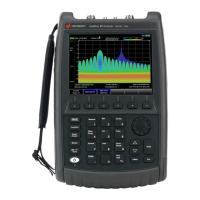290 Keysight N9938-90003 User’s Guide
Safety Considerations
Battery Protective Functions
Battery Protective Functions
This section contains the following:
— “Battery Protective Functions (N9910X-876)”
— “Battery Protective Functions (N9910X-870)” on page 292
Battery Protective Functions (N9910X-876)
The following protective functions are designed into the lithium-ion
rechargeable battery system used in FieldFox.
The protective functions can be divided between two categories: active and
passive. Active protection refers to the type of protection that depends on at
least two or more protection devices working together to enable the protection
Passive protection refers to the type of protection that is always enabled
independent of any other protection device.
Active Protection
Primary Overcharge Voltage: This prevents the battery from being charged if
the voltage across any cell exceeds approximately 4.25 V per cell. Once the
overcharge protection is tripped, the voltage across each cell must drop below
approximately 4.10 V to reset the protection and permit charging.
Overdischarge Voltage: This prevents the battery from discharging if the
voltage across any cell drops below approximately 2.5 V. Once the
overdischarge voltage protection is tripped, the voltage across each cell must
be charged to approximately 3 V to reset the protection and permit
discharging.
Primary Overcharge Current: This prevents the battery from being charged if
the average charging current reaches or exceeds 3.3A for a time period of 5
seconds or more.
Primary Overdischarge Current: This prevents the battery from being
discharged if the average current out of the battery reaches or exceeds 7A for a
time period of 5 seconds or more. This protection can be reset by removing the
load.
Short Circuit Protection: This prevents the battery from being charged or
discharged and protects against damage or lost data if the current in or out of
the battery reaches or exceeds 33.3A for a time period of 274.5 microseconds
or more. This protection can be reset by removing the load.
Overtemperature Charging: The system microcontroller prevents the battery
from being charged if the cell temperature exceeds 48C. Once the
overtemperature charging protection is tripped, the cell temperature has to
drop to or below 43C to reset the protection and permit charging.

